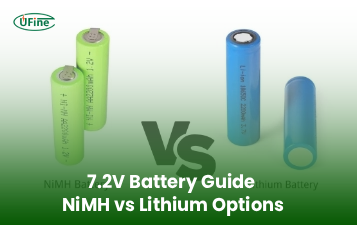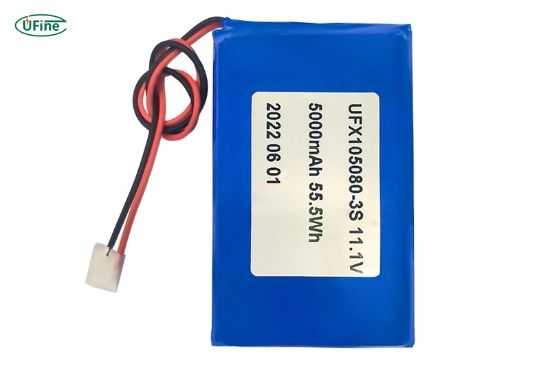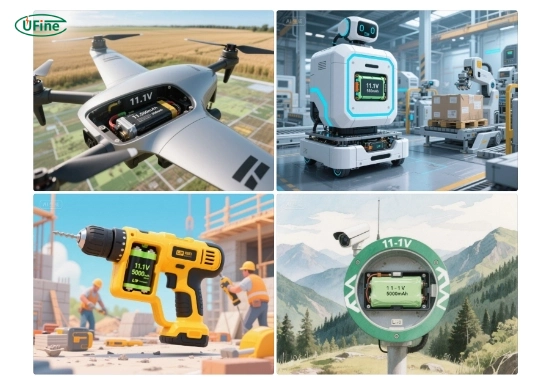
- Part 1. What is an 11.1V LiPo battery 5000mAh?
- Part 2. Why do voltage and capacity matter in industrial settings?
- Part 3. Key technical specifications of 11.1V 5000mAh LiPo batteries
- Part 4. Common industrial applications of 11.1V 5000mAh LiPo batteries
- Part 5. How long does an 11.1V 5000mAh battery last?
- Part 6. Understanding the discharge rate (C-rating)
- Part 7. LiPo battery connector types for industrial use
- Part 8. Charging and safety tips
- Part 9. Benefits of using 11.1V 5000mAh LiPo batteries in industry
- Part 10. Maintenance tips for longer lifespan
- Part 11. FAQs about 11.1V LiPo battery 5000mAh
What is an 11.1V LiPo battery 5000mAh, and why is it crucial for industrial applications?
An 11.1V LiPo battery with a 5000mAh capacity is a high-capacity lithium polymer power source used in devices that require consistent energy delivery and lightweight power solutions. This type of battery is widely used in industrial settings due to its reliable voltage, long runtime, and high discharge performance. Whether it is powering drones, robotics, or portable tools, this battery plays a vital role in keeping operations running smoothly.
In this comprehensive guide, we will explore every aspect of the 11.1V LiPo 5000mAh battery, including technical specifications, safety tips, industrial applications, connector types, and frequently asked questions. This article is written for engineers, industrial buyers, and professionals who need to understand why this battery matters.
Part 1. What is an 11.1V LiPo battery 5000mAh?
An 11.1V LiPo battery 5000mAh is a rechargeable lithium polymer battery that contains three cells connected in series, each with a nominal voltage of 3.7 volts. As a result, the total voltage of the battery is 11.1 volts. The 5000mAh capacity means the battery can deliver 5000 milliamps of current for one hour under ideal conditions.
This battery is part of the 3S LiPo battery family, where “3S” stands for three cells in series. These batteries are known for their high energy density, flat and compact design, and ability to deliver high current output. They are commonly used in both consumer and industrial-grade equipment due to their efficiency and lightweight structure.
Part 2. Why do voltage and capacity matter in industrial settings?
Voltage and capacity are two of the most important battery parameters in industrial operations. The voltage determines the electrical pressure that drives current through a device. A 11.1V battery provides a stable voltage that is suitable for many DC-powered machines, ensuring consistent performance without dips or surges.
The 5000mAh capacity indicates the amount of energy the battery can store and deliver. A higher capacity means a longer runtime, which is especially beneficial in industrial applications where downtime can be costly. For example, in a warehouse automation system, a high-capacity battery can keep robotic vehicles moving for extended periods without interruption.
In summary, high voltage and large capacity translate to more reliable and efficient power delivery in mission-critical environments.
Part 3. Key technical specifications of 11.1V 5000mAh LiPo batteries
Understanding the specifications of this battery helps in matching it to the right application. Here is a detailed overview of its core characteristics:
| Feature | Details |
|---|---|
| Nominal Voltage | 11.1 Volts |
| Capacity | 5000mAh or 5 Amp-hours |
| Cell Configuration | 3S (3 cells in series) |
| Discharge Rate | Typically between 20C and 60C |
| Maximum Continuous Current | Up to 100 Amps (at 20C) |
| Dimensions | Around 135 mm x 45 mm x 25 mm (varies by brand) |
| Weight | Approximately 350 to 500 grams |
| Connectors | XT60, Deans, EC3, EC5, or custom |
| Charge Time | 1 to 2 hours with the correct charger |
| Cycle Life | Generally 300 to 500 full charge cycles |
These specifications are essential when selecting a battery for a specific industrial task. Always ensure that your device can handle the voltage and current provided by the battery.
Part 4. Common industrial applications of 11.1V 5000mAh LiPo batteries
The 11.1V 5000mAh LiPo battery has become a standard power source in numerous industrial applications. Here are some of the most common use cases:
1. Industrial drones and UAVs
Drones used in surveying, mapping, and inspection require lightweight batteries that provide long flight times. The 11.1V battery offers an ideal balance between weight and power output.
2. Robotics and automation
Autonomous robots and automated guided vehicles (AGVs) rely on consistent power for motors, sensors, and processors. A LiPo battery ensures smooth operation across multiple shifts.
3. Portable industrial tools
Tools such as handheld drills, ultrasonic testers, and torque wrenches benefit from high-capacity batteries that allow extended use without constant recharging.
4. Remote monitoring systems
Systems deployed in locations without access to grid power, such as weather stations or pipeline monitors, use these batteries for energy storage.
5. Medical and scientific instruments
Portable medical devices need reliable power that is compact and transportable. LiPo batteries meet these requirements while ensuring safety and longevity.
Part 5. How long does an 11.1V 5000mAh battery last?
The runtime of an 11.1V 5000mAh battery depends on the current draw of the device it powers. The basic formula to estimate runtime is:
Runtime (hours) = Battery Capacity (Ah) / Load Current (A)
For example:
- If your device draws 5 Amps, the battery will last approximately 1 hour.
- If it draws 2.5 Amps, the battery will last about 2 hours.
- At 10 Amps, the expected runtime would be around 30 minutes.
It is essential to consider the device’s efficiency and any power losses in the system, as these can reduce the actual runtime.
Part 6. Understanding the discharge rate (C-rating)
The C-rating tells you how quickly the battery can be safely discharged. A battery with a 20C rating and 5000mAh capacity can deliver:
20 x 5A = 100A of continuous current
For high-powered industrial applications, a higher C-rating ensures that the battery can handle the energy demands without overheating or degrading prematurely. Always choose a C-rating that exceeds your device’s maximum current draw to avoid overloading.
Part 7. LiPo battery connector types for industrial use
The connector type is a critical yet often overlooked component of LiPo battery systems. It determines how safely and efficiently the battery connects to the device. Here are the most common connectors used in industrial-grade 11.1V 5000mAh LiPo batteries:
XT60
This is one of the most popular connectors for mid-power applications. It provides a solid connection and can handle currents up to 60A. XT60 connectors are easy to use and very reliable.
Deans (T-plug)
Known for their compact size, Deans connectors are widely used in robotics and remote control systems. They offer low resistance and are suitable for moderate current loads.
EC3 and EC5
These connectors are designed for higher current applications. The EC3 can handle around 60A, while the EC5 can manage up to 120A. They are commonly found in heavy-duty drones and electric vehicles.
JST (Japan Solderless Terminal)
JST connectors are used in low-current applications such as small sensors or control boards. They are not suitable for high-draw devices.
Anderson Powerpole
These are modular connectors used in professional and industrial-grade systems. They are durable, stackable, and support both low and high-current requirements.
Custom connectors
In some industries, devices require unique or proprietary connectors. Many battery manufacturers offer customization services to help match the battery with specific hardware.
Choosing the right connector ensures efficient power transfer, safety, and compatibility with your existing systems.
Part 8. Charging and safety tips
Charging LiPo batteries requires attention to detail to prevent accidents and extend battery life.
Charging Tips
- Always use a LiPo-compatible smart charger.
- Charge at a current of 1C, which is 5A for a 5000mAh battery.
- Place the battery on a non-flammable surface during charging.
- Use a LiPo-safe bag or container.
Safety Tips
- Do not puncture, crush, or expose the battery to high heat.
- Never charge a swollen or damaged battery.
- Avoid over-discharging below 3.0V per cell.
- Store at 3.8V per cell if not in use for more than a week.
- Regularly inspect for signs of wear or swelling.
Following these guidelines ensures that your battery performs well and remains safe throughout its service life.
Part 9. Benefits of using 11.1V 5000mAh LiPo batteries in industry
The advantages of this battery are numerous and contribute to its broad adoption across industries.
- High energy density allows for compact and lightweight designs.
- Long runtime supports continuous usage in critical applications.
- Fast charging capabilities reduce downtime.
- High discharge rates support powerful devices.
- Flexible installation due to customizable sizes and connectors.
- Cost-effective over time thanks to rechargeable design and long cycle life.
These benefits make the 11.1V 5000mAh battery a smart investment for industrial users.
Part 10. Maintenance tips for longer lifespan
Proper maintenance ensures that your battery provides maximum performance over time.
- Store batteries in a cool, dry place at 40 to 60 percent charge.
- Use a battery balancer to maintain equal voltage across all cells.
- Clean connectors regularly to prevent poor contact.
- Label each battery with purchase and usage dates.
- Use a battery monitor to track voltage and temperature during use.
With these simple practices, your battery can achieve a longer cycle life and better reliability.
Part 11. FAQs about 11.1V LiPo battery 5000mAh
Can I use an 11.1V 5000mAh LiPo battery in a 12V device?
Yes, most 12V devices tolerate an input range that includes 11.1V. However, always check the device’s voltage tolerance before connecting.
How many charge cycles can I expect from an 11.1V 5000mAh battery?
You can expect between 300 to 500 full charge cycles, depending on how well the battery is maintained and how frequently it is used.
Is an 11.1V LiPo battery safe for industrial operation?
Yes, as long as it is used within its specifications and charged properly. Using certified chargers and avoiding physical damage ensures safety.
What should I do with a damaged or swollen LiPo battery?
Stop using it immediately. Discharge it safely if possible and dispose of it at a certified battery recycling center.
What is the best way to store a LiPo battery when not in use?
Store it at 3.8 volts per cell in a cool and dry environment. Use a fire-safe battery container for added security.
Related Tags:
More Articles

NiMH vs Lithium 7.2V Battery and Charger: Which Is Better?
Compare 7.2V NiMH vs Lithium batteries and chargers in 2025. Learn runtime, weight, charging, lifespan, and cost to choose the best for your device.
How to Choose the Right 7.2V Battery and Charger for Your Device?
Learn how to choose the right 7.2V battery and charger for optimal performance, safety, and longevity across RC, tools, medical, and industrial devices.
Big Square Battery Safety Standards You Must Know
Learn key safety standards for big square batteries to avoid fire risks, shipping delays, and compliance issues in EV, industrial, and energy storage projects.
Big Square Battery Applications in Solar & Industrial Equipment
Big square batteries deliver high capacity, stable output, and long life for solar, industrial, and backup power. Explore key uses and advantages.
Big Square Battery vs Cylindrical Battery: Complete 2025 Guide for EVs, ESS & Industrial Devices
Choosing the right battery is key for designers and engineers. Compare big square vs cylindrical batteries to find the best fit for your application.




